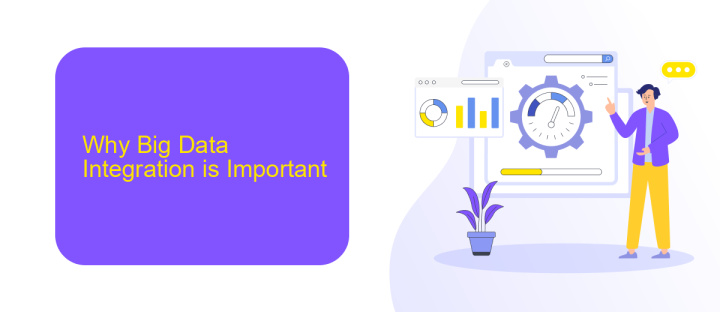What is Big Data Integration
Big Data Integration refers to the process of combining large volumes of diverse data from various sources into a unified system to enable comprehensive analysis and decision-making. This integration is essential for organizations to harness the power of big data, uncover valuable insights, and drive strategic initiatives. Understanding Big Data Integration is crucial for leveraging data's full potential in today's data-driven world.
What is Big Data Integration
Big Data Integration refers to the process of combining large volumes of diverse data from various sources into a unified view, enabling more comprehensive analysis and insights. This process is crucial for organizations looking to leverage big data for strategic decision-making and operational efficiency.
- Data Extraction: Collecting data from multiple sources, such as databases, APIs, and streaming services.
- Data Transformation: Converting data into a consistent format to ensure compatibility and usability.
- Data Loading: Storing the transformed data into a centralized repository, such as a data warehouse or data lake.
- Data Quality Management: Ensuring the accuracy, completeness, and reliability of the integrated data.
- Data Governance: Implementing policies and procedures to manage data access, security, and compliance.
Tools like ApiX-Drive can streamline the Big Data Integration process by automating data extraction, transformation, and loading tasks. These platforms offer user-friendly interfaces and pre-built connectors, making it easier to integrate data from various sources without extensive coding knowledge. By leveraging such tools, organizations can achieve faster and more efficient data integration, leading to better insights and decision-making.
Why Big Data Integration is Important

Big Data Integration is crucial for modern businesses as it enables the seamless merging of vast and varied data sources into a unified system. This integration facilitates comprehensive data analysis, providing valuable insights that drive informed decision-making. By consolidating data from different platforms, companies can identify trends, optimize operations, and enhance customer experiences, ultimately leading to increased efficiency and competitiveness.
Moreover, tools like ApiX-Drive simplify the integration process by offering automated, user-friendly solutions that connect various data sources without the need for extensive technical expertise. This allows businesses to focus on leveraging their data rather than getting bogged down by the complexities of integration. With efficient Big Data Integration, organizations can unlock the full potential of their data, leading to innovative strategies and sustained growth.
Challenges of Big Data Integration

Integrating big data is a complex task that presents numerous challenges. These challenges can hinder the effective utilization of data and impact business decisions. Understanding these challenges is crucial for successful big data integration.
- Data Variety: Big data comes from diverse sources and in various formats, making it difficult to standardize and integrate.
- Volume and Velocity: The sheer volume and speed at which data is generated can overwhelm traditional data processing systems.
- Data Quality: Ensuring the accuracy, completeness, and reliability of data is a significant obstacle.
- Scalability: As data grows, the integration solutions must scale appropriately to handle increased loads.
- Security and Compliance: Protecting sensitive data and complying with regulations is a constant concern.
To address these challenges, businesses can leverage integration platforms like ApiX-Drive. ApiX-Drive simplifies the process by offering automated data synchronization between various systems, ensuring data integrity and reducing manual workload. By utilizing such services, organizations can overcome the complexities of big data integration and focus on deriving actionable insights from their data.
Benefits of Big Data Integration

Big Data Integration is a pivotal process for organizations looking to leverage vast amounts of data from various sources. By integrating big data, companies can achieve a more comprehensive view of their operations, customers, and market trends, leading to better decision-making and strategic planning.
One of the primary benefits of Big Data Integration is the ability to unify disparate data sources into a single, cohesive dataset. This enables businesses to analyze data more effectively and extract actionable insights. Additionally, integrated data can improve operational efficiency by streamlining processes and reducing redundancy.
- Enhanced data accuracy and consistency
- Improved decision-making capabilities
- Greater operational efficiency
- Increased competitive advantage
- Better customer insights
Utilizing tools like ApiX-Drive can simplify the integration process by automating data transfer between various applications and services. This not only saves time but also ensures that data is consistently up-to-date and accurate, allowing businesses to focus on analyzing and utilizing their data rather than managing it.
- Automate the work of an online store or landing
- Empower through integration
- Don't spend money on programmers and integrators
- Save time by automating routine tasks
Best Practices for Big Data Integration
Effective big data integration requires a strategic approach to ensure seamless data flow and accurate insights. Begin by establishing clear objectives and understanding the specific data requirements of your organization. Prioritize data quality by implementing robust data governance practices, including data validation, cleansing, and standardization. Utilize scalable and flexible integration tools that can handle the volume, variety, and velocity of big data. Continuous monitoring and real-time analytics are essential to detect and resolve any integration issues promptly.
Leveraging advanced integration platforms like ApiX-Drive can significantly streamline the process. ApiX-Drive offers automated workflows and easy-to-use interfaces that simplify the integration of diverse data sources. By automating repetitive tasks, it reduces the risk of human error and enhances efficiency. Additionally, ensure your integration strategy includes security measures to protect sensitive data. Regularly update and test your integration processes to adapt to evolving data landscapes and maintain optimal performance. By following these best practices, organizations can achieve a cohesive and reliable big data integration framework.
FAQ
What is Big Data Integration?
Why is Big Data Integration important?
What are the challenges associated with Big Data Integration?
How can automation help in Big Data Integration?
What are some best practices for Big Data Integration?
Apix-Drive is a simple and efficient system connector that will help you automate routine tasks and optimize business processes. You can save time and money, direct these resources to more important purposes. Test ApiX-Drive and make sure that this tool will relieve your employees and after 5 minutes of settings your business will start working faster.


